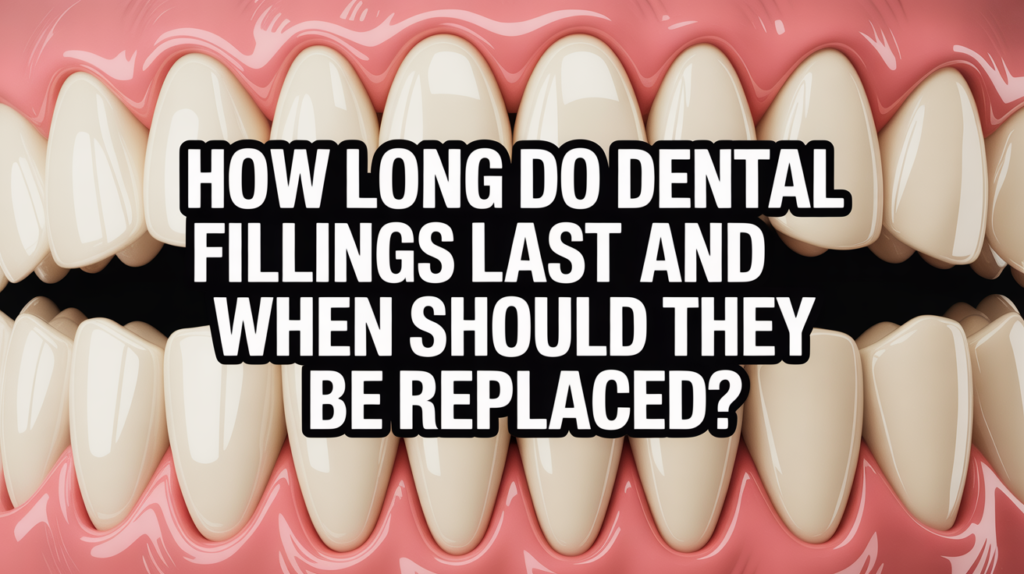How Long Do Dental Fillings Last and When Should They Be Replaced?
Introduction
Dental fillings are one of the most common solutions for repairing cavities or damaged teeth. They help restore functionality, prevent further decay, and maintain a healthy smile 😊. Understanding how long dental fillings last is crucial because it ensures you can take timely action to protect your oral health. No one wants to deal with unexpected tooth pain or costly repairs down the road!
In this article, we’ll explore the lifespan of different filling materials, factors that influence their durability, signs that indicate replacement is needed, and tips to extend their life. Whether you’re someone who already has fillings or just curious about dental care, this guide will provide valuable insights to keep your teeth strong and healthy.
Average Lifespan of Different Dental Filling Materials
The longevity of dental fillings varies significantly depending on the material used. Composite resin fillings, which blend seamlessly with natural teeth, typically last between 7-10 years. Amalgam fillings, known for their silver appearance, tend to be more durable and can last up to 15 years. Gold fillings, though expensive, offer exceptional durability, lasting anywhere from 10-30 years. Ceramic or porcelain fillings combine aesthetics and strength, often enduring for around 15 years.
Glass ionomer fillings, commonly used for children or small cavities near the gum line, have the shortest lifespan-lasting only up to 5 years. While these numbers give a general idea, it’s essential to remember that individual habits and oral health play a significant role in determining how long a filling lasts. Now, let’s dive into what influences their longevity even further.
What Factors Influence the Longevity of a Dental Filling?
Several factors impact how long a dental filling remains effective. Proper oral hygiene practices like brushing twice daily and flossing regularly can greatly enhance its lifespan. Eating habits also matter; chewing hard foods or frequently consuming sugary snacks can wear down fillings faster. Additionally, the size and location of the filling affect its durability-a larger filling under constant pressure may not last as long as a smaller one.
Other external factors include teeth grinding (bruxism) and accidental trauma, both of which can damage fillings prematurely. Even if you take excellent care of your teeth, regular dental checkups are vital to catch issues early before they escalate. By understanding these influences, you can better protect your investment in your dental health.
Types of Dental Fillings Explained
Composite resin fillings are popular due to their tooth-colored appearance, making them ideal for front teeth. They bond directly to the tooth structure, providing good support but are less durable than other options. Amalgam fillings, made from a mix of metals, are highly durable and cost-effective, though their metallic look makes them less appealing for visible areas. These are often recommended for molars where strength matters most.
“Dental fillings usually last anywhere from seven to 30 years, depending on the type.” -CareCredit
Gold fillings are prized for their longevity and resistance to corrosion, but they come at a higher price point and require multiple visits to install. Ceramic or porcelain fillings offer a balance of aesthetics and durability, though they can be brittle compared to metal-based alternatives. Lastly, glass ionomer fillings release fluoride, helping prevent decay, but their shorter lifespan limits their use to specific cases, like baby teeth or non-biting surfaces.
Each type of filling has unique advantages and drawbacks, so choosing the right one depends on your budget, aesthetic preferences, and the condition of your teeth. Consulting with your dentist can help determine the best option for your needs.
“Composite resin: Seven to 10 years. Amalgam (silver): 10 to 15 years or more. Gold: 10 to 30 years. Porcelain: Up to 15 years. Glass ionomer: Up to 15 years. Temporary: 30 days.” -CareCredit
Signs That a Dental Filling Needs to Be Replaced
Knowing when to replace a dental filling is key to avoiding complications. Common signs include persistent pain, increased sensitivity to hot or cold temperatures, or discomfort while chewing. Visible cracks, chips, or discoloration around the filling are also red flags. If bacteria sneak under the filling, it can lead to recurring decay, which compromises the tooth’s integrity.
Ignoring these symptoms can result in bigger problems, such as infections or fractures. Don’t wait until the issue worsens-schedule an appointment with your dentist as soon as you notice any warning signs. Early intervention saves time, money, and unnecessary pain! 💔
“Other factors affecting the life span of a filling include your eating habits, dental hygiene, trauma to your tooth, decay around the filling, grinding your teeth while you sleep.” -Healthline
How Dentists Determine When a Filling Should Be Replaced
Dentists rely on various diagnostic techniques to assess whether a filling needs replacement. During routine exams, they visually inspect the filling for signs of wear, cracks, or discoloration. They may also use specialized tools to probe the edges of the filling, checking for roughness or gaps that could indicate marginal leakage. X-rays are another valuable tool, revealing hidden decay beneath the surface.
Clinical indicators for replacement include degeneration of the filling material, recurrent decay, or loss of function. For example, if the filling no longer fits snugly against the tooth, it creates space for bacteria to thrive. Regular checkups ensure these issues are caught early, allowing for prompt treatment and preventing more extensive damage.
“If you start noticing pain or discomfort where you have a filling, it may be time to replace it.” -CareCredit
Risks of Delaying Replacement of Old or Damaged Fillings
Failing to replace an old or damaged filling can lead to serious consequences. In the short term, you might experience heightened sensitivity or discomfort. Over time, secondary decay can develop, spreading to surrounding areas and weakening the entire tooth structure. This increases the risk of fractures, which may necessitate costly procedures like root canals or crowns.
Long-term neglect can also contribute to gum disease, as bacteria accumulate around compromised fillings. Ultimately, delaying replacement often results in more invasive-and expensive-treatments. Staying proactive about your dental health helps avoid these complications and keeps your smile intact! 😁
“Brushing and flossing regularly can help prevent decay and keep your fillings functional for longer.” -FWDentalAssociates
Temporary Fillings vs. Permanent Fillings: How Long Do They Last?
Temporary fillings are designed for short-term use, typically lasting only 6-8 weeks. They’re often used in situations like emergency repairs, root canal treatments, or when additional adjustments are needed before placing a permanent filling. On the other hand, permanent fillings are built to endure daily wear and tear, lasting several years depending on the material. Understanding the difference ensures you know what to expect based on your dental situation.
How to Prolong the Life of Your Dental Fillings
Taking steps to care for your fillings can significantly extend their lifespan. Practicing good oral hygiene is the foundation-brush twice daily with fluoride toothpaste and floss at least once a day. Regular dental cleanings and exams allow professionals to monitor your fillings’ condition and address minor issues before they become major problems. Avoid biting down on hard objects like ice or pens, as this can chip or crack your fillings.
“Temporary fillings are designed only to last approximately 6-8 weeks.” -Gentle Dental
Reducing consumption of acidic or sugary foods and drinks also helps protect your teeth and fillings. If you grind your teeth at night, consider using a mouthguard to minimize stress on your fillings. With consistent effort, you can maximize the life of your fillings and enjoy a healthier smile for years to come! 🦷✨
Costs Associated with Replacing Dental Fillings
The cost of replacing a dental filling depends on several factors, including the type of material chosen, the extent of the damage, and your dentist’s expertise. Composite fillings are generally affordable, while gold and ceramic options can be pricier due to their superior quality and aesthetics. Insurance coverage varies; some plans fully cover basic fillings, while others may require partial payment for premium materials.
“On average fillings last 20 years when made of gold, 15 years for ceramic and porcelain, 10-15 years for amalgam, 7 years for composite, and less than 5 years for glass ionomer.” -Gentle Dental
It’s always wise to discuss costs upfront with your dentist and review your insurance policy. Many dentists offer flexible payment plans or financing options to make treatment accessible. Investing in high-quality fillings now can save you money in the long run by reducing the need for frequent replacements or complications.
Alternatives to Traditional Dental Fillings
For larger cavities or severely damaged teeth, alternatives like inlays, onlays, or crowns may be recommended. Inlays and onlays are custom-made restorations that fit precisely into the affected area, offering greater durability than traditional fillings. Crowns, which cover the entire tooth, provide maximum protection and are ideal for extensively weakened teeth. These options ensure both functionality and aesthetics, tailored to meet individual needs.
“Ceramic fillings…have been found to last on average 10-15 years with proper care. Research is ongoing as this is a newer material.” -FWDentalAssociates
What to Expect During a Filling Replacement Procedure
Replacing a dental filling involves removing the old material and cleaning out any decay before applying the new filling. Local anesthesia is usually administered to numb the area, ensuring minimal discomfort during the procedure. Once the cavity is prepped, the dentist carefully places and shapes the new filling to match your bite.
Afterward, you may experience slight sensitivity, but this typically subsides within a few days. Follow your dentist’s aftercare instructions, such as avoiding very hot or cold foods temporarily. Recovery is quick, and most patients resume normal activities immediately. With proper care, your new filling should serve you well for many years! ✅
FAQ – How Long Do Dental Fillings Last and When Should They Be Replaced?
1. Can dental fillings last a lifetime?
Unfortunately, most dental fillings don’t last forever. While some materials, like gold, can endure for decades, factors like wear and tear, oral hygiene, and diet eventually take their toll. Regular dental visits are essential to monitor the condition of your fillings and replace them as needed.
2. What causes a filling to fail sooner than expected?
Several factors can shorten a filling’s lifespan, including bruxism (teeth grinding), poor oral hygiene, trauma, and consuming hard or sticky foods. Acidic beverages and sugary snacks can also accelerate decay around the filling, leading to premature failure.
3. Does insurance cover replacing old fillings?
Most dental insurance policies cover fillings, but coverage specifics vary. Some plans limit replacements to every few years, while others focus on medically necessary procedures. Review your policy details or consult your provider to understand your benefits.
4. Is it painful to have a filling replaced?
Thanks to modern techniques and local anesthesia, replacing a filling is generally pain-free. You might feel slight pressure during the procedure, but discomfort is minimal. Post-procedure sensitivity is normal and usually resolves quickly.
5. Are there new materials for fillings that last longer?
Advancements in dental materials continue to improve filling longevity and performance. Researchers are exploring stronger composites and bioactive materials that release minerals to strengthen teeth. These innovations promise even better outcomes in the future!
Conclusion
In summary, dental fillings play a vital role in maintaining oral health, but their lifespan depends on various factors, including material choice, oral hygiene, and lifestyle habits. Recognizing the signs of a failing filling and seeking timely replacement can prevent more severe dental issues. Regular checkups are your best defense against unnoticed problems, ensuring your fillings remain in top shape.
If you’re unsure about the condition of your existing fillings or experiencing symptoms like pain or sensitivity, don’t hesitate to contact your dentist. Scheduling an evaluation allows you to address potential concerns early and plan for optimal replacement timing. Your smile deserves the best care possible-take the first step today! 🌟



